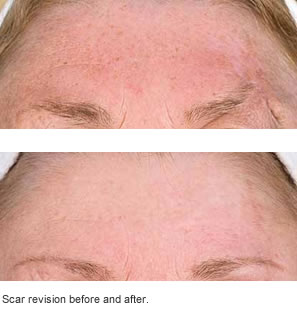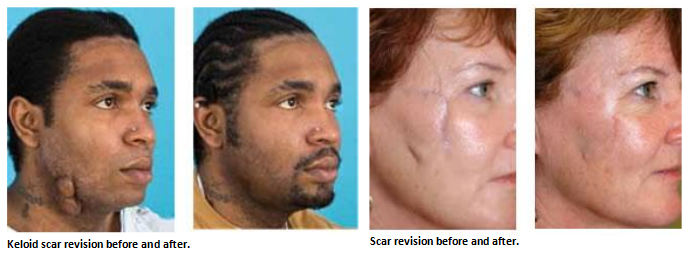Scar Revision
Understanding Facial Scar Treatment
When the skin is injured from a cut or tear, the body heals by forming scar tissue. The appearance of the scar can range from nearly invisible to very obvious and disfiguring. Unattractive scars can be wide, sunken, red, raised, pale, or even cause distortion of other parts of the face like the eyes or lips. A facial plastic surgeon has many options for treating and improving facial scars.
After the accident, I thought I would never look normal again. The injuries healed, but the scars couldn’t be concealed with makeup. People stared at me, and it bothered me to look the way I did. Now, after three revision procedures, I look much better. The scars are not completely gone, but I feel much better about the way I look. It helped me to put the accident behind me.
— laurag., age 34

Understanding the Surgery
The various surgical techniques for scar revision are designed to make the scar as smooth and invisible as possible. This can involve recreating the incision, moving skin around or even moving the scar to make it less visible. What would work best for your specific scar will depend on where it is located and how it looks. Your surgeon will evaluate you and discuss the options for revision surgery.
Some scars, especially when raised, may be improved with dermabrasion and laser resurfacing. These are methods a surgeon uses to make “rough or elevated” scars less prominent, by removing part of the upper layers of skin with an abrading tool or laser light. Clearly, the scar will remain, but should be smoother and less visible.
Keloid or hypertrophic scars are often treated first with injection of medications to reduce size. If this is unsatisfactory, the scars can be removed surgically, and the incisions closed with fine stitches, often resulting in less prominent scars.

Often more than one treatment or a combination of techniques is needed to attain the best results.
What to Expect After the Surgery
You can expect to feel some discomfort after facial scar-revision surgery. Some degree of swelling, bruising, and redness is expected in the early phase of healing. It is important for you to follow your surgeon’s after-care recommendations to the letter. Though the sutures will be removed within days after the surgery, your skin needs time to heal. Surgeons generally insist on decreased activity after surgery and instruct the patient to keep the head elevated when lying down, to use cold compresses to reduce swelling, and to avoid any activity that places undue stress on the area of the incision. Depending on the surgery performed and the site of the scar, the facial plastic surgeon will explain the types of activities to avoid. No medication should be taken without first consulting the surgeon. It is important to remember that scar tissues require a year or more to fully heal and achieve a maximally improved appearance.
Facial plastic surgery makes it possible to correct facial flaws that can undermine self-confidence. Changing how your scar looks can help change how you feel about yourself.
Insurance does not generally cover surgery that is purely for cosmetic reasons. Surgery to correct or improve scars caused by injury may be reimbursable in whole or in part. It is the patient’s responsibility to check with the insurance carrier for information on the degree of coverage.
No matter how bad a scar looks, it usually can be made to look better. Scar revision treatment results can take a year or longer to mature.